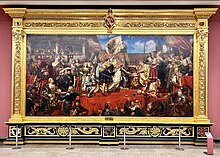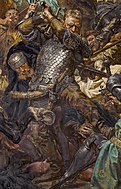Battle of Grunwald (Matejko)
| Battle of Grunwald | |
|---|---|
National Museum, Warsaw |
The Battle of Grunwald is a painting by
The painting's main focus is the death scene of the
History


Matejko began collecting materials for the painting in 1871. He started painting the canvas some time in 1872 and finished it in 1878.
Like many other works, the Battle of Grunwald was hidden by Poles, during the
Restored after World War II, since 1949 this
Composition
The Battle of Grunwald is a painting by Matejko that portrays events from the
Another central scene depicts the death of the
-
Vytautas the Great
-
Zawisza Czarny
Other notable figures depicted in the painting include:
- Marcin of Wrocimowice, Polish knight, is holding the Polish banner in the center, next to Vytautas;[3][11]
- Zyndram of Maszkowice, another Polish knight, is holding a sword over von Jungingen's head;[3][11]
- Mikołaj Skunarowski (also known as Skunaczewski) is another Polish knight, standing next to Zyndram; after the battle he would be sent with the capture standard to Kraków, as a symbol of victory;[11]
- Werner von Tettingen, German knight and one of the Teutonic Order's leaders, witnesses his leader's death from the left side of the painting;[3][10]
- near von Tettingen, Casimir V, Duke of Pomerania, an ally of the Order, is taken prisoner by the knight Jakub Skarbek z Góry and his squire;[3][10]
- at the bottom, Konrad VII the White is taken prisoner, and Kuno von Lichtenstein is dying. Matejko portrayed Konrad as a traitor, whereas German knight von Lichtenstein is shown dying with honor;[3][11]
- to the right, Jan Žižka, a Czech ally of Poland, is killing a German knight Heinrich von Schwelborn;[3][11][12]
- next to Žižka,
- to the right of Zawisza, in a shining steel helmet, is another Polish knight, Domarat Grzymalczyk of Kobylany, later a castellan of Lublin;[12]
- German knight Cossack;[12]
- another German knight is clutching von Salzbach's garb, this is Johan von Wenden;[12]
- future Grand Master Heinrich von Plauen is to the right of the painting as well, escaping to organize the defense of the remains of the Order's territory;[2][3][12]
- behind von Plauen is a figure Matejko identified as Krzysztof, bishop of Lübeck. Modern historians have however failed to associate this figure with any historical person, noting that there was no bishop of this or similar time at contemporary Lübeck;[12]
- to the right of von Plauen is a Polish knight and dignitary Jan Długosz of Niedzielsk, father of the chronicler Jan Długosz;[12]
- future cardinal Zbigniew Oleśnicki is shown as one of Jagiełło's advisers.[3] Near Władysław are also: his relative, Zygmunt Korybut, Deputy Chancellor of the Crown, Mikołaj Trąba, Siemowit IV, Duke of Masovia.[12] On the ground under Oleśnicki is the body of the German knight Dippold Kikeritz who tried to charge Jagiełło, but was felled by his entourage.[12]
Matejko combined three key parts of the battle into one tableau: an opportunistic attack by German knight Kökeritz on Jagiełło, the death of the Grand Master, and the taking of the Teutonic camp (in the top left corner).[7] Unlike many other paintings of battles, the Battle of Grunwald does not separate the viewer from the action; instead it places him at the center of it.[1] Matejko said he felt like a "possessed man" while he made the painting.[1]
Matejko based the painting in part on a description of the battle in Długosz' chronicles, which accounts for several historical inaccuracies.[3] At the same time, he was meticulous about correctly depicting the terrain of the battle, having visited the site of the conflict in 1877.[3]
Significance

The painting has been called a masterpiece depiction of a battle scene,[13] and much more than a simple depiction of a bloody battle.[3] It is a complex picture, requiring more than a cursory look; a French critic, viewing it in Paris in 1879, declared that it was a museum in its own right, requiring eight days of study before one could properly appreciate it.[1] At the same time, critics have pointed to the unrealistic depiction of the battle, and some anachronistic accessories present in the painting.[3] Others have criticized the painting for being too crowded and chaotic.[2][3]
The painting can be seen as Matejko's warning to
The painting, one of Matejko's most recognizable works and one of the best known paintings in Poland, likely has contributed to the popular image of the battle of Grunwald, and its enduring fame in Polish consciousness.[2] The painting inspired Stanisław Wyspiański, who mentioned it in several of his works.[3]
References
- ^ a b c d e f g h i Batorska, Danuta. The Political Censorship of Jan Matejko. Art Journal, ISSN 0004-3249, 06/1992, Volume 51, Issue 1, p. 57 (JSTOR)
- ^ a b c d e f g h i j k "Jan Matejko: "Bitwa pod Grunwaldem"" (in Polish). Histmag. Retrieved 2012-02-17.
- ^ a b c d e f g h i j k l m n o p q r s t u Rezler, Marek. "Z Matejką przez polskie dzieje: Bitwa pod Grunwaldem" (in Polish). Interklasa: polski portal edukacyjny. Retrieved 11 September 2011.
- ^ Rezler, Marek. "Z Matejką przez polskie dzieje: Hołd pruski" (in Polish). Interklasa: polski portal edukacyjny. Retrieved 11 September 2011.
- ^ ""Bitwa pod Grunwaldem" w ruinie - Wiadomości i informacje z kraju - wydarzenia, komentarze - Dziennik.pl" (in Polish). Wiadomosci.dziennik.pl. 2010-02-02. Retrieved 2012-02-17.
- ^ Centrum Informacyjne MKiDN (2012-09-21). "Dzieło Matejki ocalone dla potomnych Ministerstwo Kultury i Dziedzictwa Narodowego - 2012". Mkidn.gov.pl. Retrieved 2014-04-03.
- ^ ISBN 978-0-521-84580-9. Retrieved 14 August 2011.
- ^ Tomas Baranauskas. Žalgirio mūšis Lietuvos istorikų darbuose
- ^ "The Turning Point in the Battle of Tannenberg (Grunwald/Žalgiris) in 1410". Archived from the original on 2016-08-15.
- ^ a b c d Roman Daszczyński. "Spacer po polu bitwy" (in Polish). Gazeta Wyborcza. Retrieved 2012-08-01.
- ^ a b c d e Roman Daszczyński. "Kto jest kim na obrazie Jana Matejki? Cz. 2" (in Polish). Gazeta Wyborcza. Retrieved 2012-08-01.
- ^ a b c d e f g h i j Roman Daszczyński (2010-07-14). "Kto jest kim na obrazie Jana Matejki, cz. 3" (in Polish). Gazeta Wyborcza. Retrieved 2012-08-01.
- ISBN 978-83-223-2115-7. Retrieved 16 February 2012.
External links
- Understanding Matejko's painting The Battle of Grunwald
- Battle of Grunwald Explained by Culture.pl
- HUNT, a podcast from Stories From The Eastern West about how the painting was hunted by the Nazi Germans






